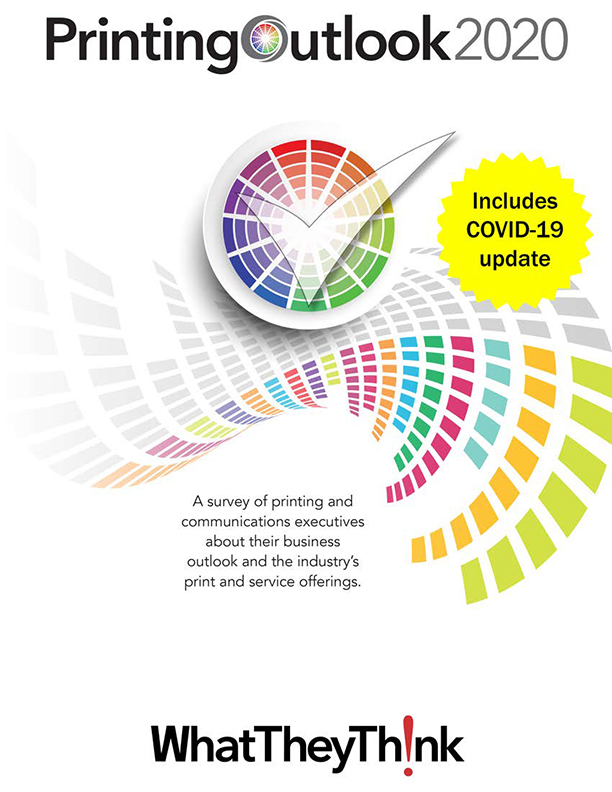Updated April 28, 2020 to include a COVID-19 Survey that we conducted Late March/Early April 2020.

The Printing Outlook 2020 report provides detailed analysis of the latest WhatTheyThink Printing Industry Survey, the latest industry economic data and macroeconomic trends, as well as industry and cultural technological trends to look out for in 2020 and beyond.
The executive report was prepared by Richard Romano and looks back at 2019 and ahead to what the industry can expect, economically and technologically, in 2020. The report features the results of the WhatTheyThink Printing Industry Business Outlook Survey conducted in Fall 2019, and includes current and expected business conditions, top business challenges, top business opportunities, and planned investments for 2020. Additional questions asked about shops’ interest in adding new specialty graphics areas such as wide-format or textile printing, as well as shops’ hiring plans for the next 12 months.
The report also offers the latest government data on printing industry shipments, establishments, profits, and employment, as well as the economy in general, and includes an industry forecast to 2028, as well as some technology and cultural trends the industry should prepare itself for in 2020.
Report highlights:
- 48% of respondents to our Fall 2019 survey said that 2019 revenues had increased by six percent or more compared to 2018.
- In terms of revenues, the strongest businesses continue to be either very small or very large shops, with the mid-size shops experiencing little revenue growth, especially when adjusted for inflation.
- “Pricing” is now reported by print business owners as their number one challenge, with “competition from other print providers” a close second.
- “Customers outsourcing more work to us” and “partnering with other print providers” were cited as the top business opportunities for 2020.
- Few print businesses have any substantial planned investments for 2020, but of those who do, binding and finishing equipment tops the list.
- One-half of print businesses said they plan to hire staff in 2020, primarily sales people.
Print business owners will find the report essential for their planning, in order to put the marketplace and their strategic actions in realistic perspective. Industry suppliers will benefit from the insights into printer decision-making processes and the foundation of new industry demographic data that debuts in this report. Non-economic trends also offer ideas for what to pay attention to in the new year, and larger cultural and technological; trends indicate where marketing professionals and brandowners will likely be focusing their promotional dollars.
What’s included in this report
Section 1 presents our Fall 2019 survey data about current (2019) and expected (2020) business conditions, specifically how print businesses fared vis-à-vis revenues, number of orders, and profits.
Section 2 presents our survey data on print businesses’ top challenges, opportunities, and planned investments.
Section 3 presents the results of our survey question asking the extent to which commercial print businesses are looking to add new capabilities like wide-format printing, textile printing, specialty printing, 3D printing, and other new products and services—or if they have added them already.
Section 4 presents the results of our survey question about print businesses’ hiring plans. Do they have any and, if so, for which positions?
Section 5 rounds up a variety of printing industry data—establishments, establishment births/deaths, shipments, profits, employment, and so on.
Section 6 provides the latest general macroeconomic data. These data are important to put industry data into the proper macroeconomic context.
Section 7 offers what we see as the hot, cold, and lukewarm trends for 2018, as well as WhatTheyThink’s economic and printing industry forecast.
The survey methodology is detailed in Appendix A. Our explanation of survivor bias is presented in Appendix B.
